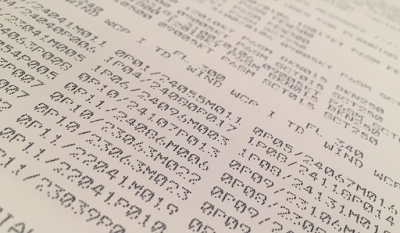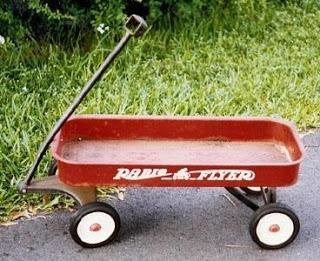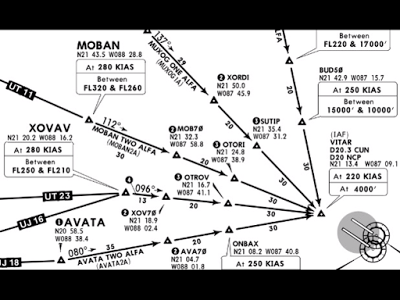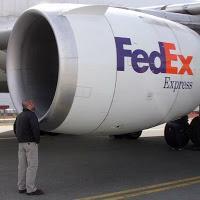The Captain and I were less than an hour into our third leg of the day. We had been scheduled at almost 13 hours on duty with nearly 9 hours of actual flying. We were tired. The sound of the wind rushing around the cockpit windows, the “buzz saw” drone of our CFM56 engines, and the black night ahead were having a very real effect on my ability to keep both eyes open. The Captain and I exchanged knowing looks; and, in an effort to stay alert, we turned up the cockpit lights, requested a couple fresh cups of coffee, and began to focus on the descent and approach into Cancun, Mexico.
The weather in Cancun was about what you might expect at a tropical beach destination in January: Warm temperatures, clear skies, unobstructed visibility, and light winds blowing out of the north (a slight tailwind for the preferred Runway, 12L). On occasion, I will request a straight in approach and accept a light tailwind in order to expedite our arrival; however, pilots generally prefer to land into the wind.By doing so, it reduces the necessary ground speed at touchdown and shortens the distance needed to land and stop the aircraft. It’s a good practice and increases the safety margin. The Air Traffic Controllers in Cancun prefer to use Runway 12L for arrivals and Runway 12R for departures. As long as the wind didn't exceed aircraft limitations, the Captain and I were willing, able, and happy to shave a few minutes off of an already long day.
In contrast to the light wind conditions on the ground, the wind at 39,000 feet was blowing out of the north at just over 140 knots and was forecasted to remain unusually strong throughout our descent. These winds would certainly have to be taken into consideration when determining how much distance would be needed to get down.
The Flight Management Computer (FMC) on a modern airliner is a capable machine that provides a plethora of information to the pilot; however, the FMC is a computer, and computers are fallible. The old adage, “bad information in, bad information out” is always on my mind when deciding how much trust to place in the FMC. Unless manually imputed into the FMC by the pilots, the FMC doesn’t know the wind conditions at any altitude other than the one currently occupied by the aircraft. The flight plan provided to me by my airline includes forecasted wind, temperature, and atmospheric pressure changes at various altitudes along our planned route…information that I had already entered into the FMC.
Getting down
In case you’re wondering what we’re doing up so high in the first place, jet aircraft fly at high altitudes because the high, thin air allows us to fly faster and burn less fuel. But determining how to get an airplane from 39,000 feet down to the runway might sound a little like a word problem fit for high school math class. An airplane is flying along at 39,000 feet at a true airspeed of 465 knots. The wind is blowing from 360 degrees at 140 knots, the temperature is standard plus 10, and the pressure altitude is 29.68 at the surface. When does the pilot need to start down in order to touchdown on the runway at 150 knots? Flight Management Computers do a lot of the brain work for the pilot; but remember, computers are fallible and can't be implicitly trusted.

Wind, temperature, and ride report from one of my recent flights.
Complicated math problems aside, I have two simple, commonly used rules of thumb to quickly confirm information provided by the FMC. First, I multiply the amount of altitude to lose by 3 to yield the miles needed to descend. I will add 1 mile for every 10 knots of airspeed I need to lose and add or subtract, as needed, to account for the wind. Second, if I can tell I won't be at 10,000 feet and 250 knots by the time I reach 30 flying miles from the airport, I will need to extend the speed brakes or come up with another plan. You could certainly make more precise computations, but these rules of thumb are effective for a quick check of the information provided by the FMC.
Radio Flyer wagon...I had one just like it!
We’ve already gone from a complicated math problem to a general rule of thumb; but, allow me to simplify things a little further.It may be a ridiculous over simplification, but getting down from cruise altitude in a jet airliner is a little like rolling down a hill in a toy wagon. When I was a kid, I had a red Radio Flyer wagon, and was a pro at finding the biggest hills in the neighborhood to race down. Picture it in your head. You crawl into your Radio Flyer at the top of a hill, nudge yourself over the top, and pull your hands and feet into the wagon. With the same wagon, the same kid, and the same hill, the wagon will travel at about the same speed each time. If you want to travel faster, find a steeper hill. If you’re a wimpy little kid and want to go slower, then pick a smaller hill. But once you’ve committed to a hill, the only way to slow down is to drag your feet.As silly as it may sound, descending a jet airplane works in much the same way. If the pilot allows the FMC to calculate the Top Of Descent (TOD) and begins his descent at the most optimal point, the aircraft will descend with the engines at idle; and, the speed at which the airplane comes down the hill will be determined by the steepness of the hill.
Choosing a hill
The pilot has two primary options when choosing a descent speed. He may choose a specific speed for the descent; or, he can allow the FMC to determine the most optimal speed, based on a number of predetermined factors. Either way, it's the speed that determines the rate of descent (or the steepness of the hill, so to speak). If the pilot wants to descend at Mach .78 and transition to 290 knots (SOP at my airline), then the airplane might descend at a little more than 2,000 feet per minute. If he wants to descend at 310 knots, the airplane will start down later (moving the TOD closer to the destination) and descend at a slightly faster rate in order to attain the desired speed. This would be the steeper hill. On the other hand, if the pilot wants to descend at 280 knots, the airplane will start down sooner (moving the TOD farther away from the destination), and descend at a slower rate. This would be the smaller hill.
As long as the wind is fairly close to the forecasted conditions and the airplane's descent speed matches the plan, the airplane should fly a near perfect descent. Perfect, meaning the airplane will descend at the speed you planned and arrive at the appropriate point at the desired speed and altitude. Unfortunately, the wind is frequently different than planned and air traffic controllers have a nasty habit of changing the descent speed after you've already started down. All of your careful planning is thrown out the window.The perfect descent is rare.
Most pilots take a lot of pride, not only in what they do, but how they do it. It isn’t enough to get the airplane down and in a position to execute a safe landing. We want to accomplish all of this as smoothly, efficiently, and safely as possible. These are important words to pilots: Smooth. Efficient. Safe. The obvious objective is to get the airplane down and slowed down in time to land, and to do so in a manner that doesn’t attract the unwanted attention of the chief pilot or the FAA. But there’s a lot more to it than that. We want to do it with finesse.
Too High
We don’t want to come in too high. Doing so requires the use of speed brakes, or the early extension of the flaps. In extreme cases, the landing gear may even be extended to induce as much extra drag as possible. All of these techniques increase noise and induce turbulence in otherwise smooth air, and would definitely result in a deduction of points if this was some sort of competition…which it most certainly is. In addition, if the airplane comes in too high for the pilot to compensate, the approach could result in a go-around...and in a pilot's mind, a go-around earns a failing grade.
This is a discussion for another day, but while the pilot may be a little embarrassed by a go-around, whether self-induced or not, in the eyes of most airlines and the FAA, a go-around is considered a successful termination to an approach. The pilot was able to recognize that the approach was not going to be "stable" and/or was not going to end with a safe landing, and chose to go around and try it again. Job well done.
Most airlines insist on what they call a stable approach. This requires the airplane to be on speed, on glide path, properly configured for landing, and with the engines stabilized at approach thrust by the time the airplane descends through 1,000 feet above the touchdown zone altitude. “Stable” is defined by each airline; and, each airline may define it in slightly different terms, but the result is the same. A safe landing is statistically more probable after a stable approach, and a go-around is, arguably, an admission that we made a mistake that put the airplane in a bad position. All this makes us look bad and wastes fuel, so we carefully plan our descents to make sure that this doesn’t happen.
Too Low
It’s much easier to compensate for getting down too soon than coming in too high. Getting down too soon almost never results in a go-around, but it does mean droning along at low altitude for an extended period of time needlessly wasting fuel. Of course, being fuel efficient is important for economic and environmental reasons, but to be perfectly honest, I preserve fuel for purely selfish reasons. Every pound of fuel I save is a pound of fuel to burn on those days when things don't go as planned. I save fuel to increase the safety margin, not the profit margin.
Back to Cancun
After a short time in Houston Oceanic airspace, we crossed into Mexican airspace and made radio contact with Merida Center. At this position, we were able to communicate with Air Traffic Control but are unable to be seen by their radar. In my short time doing this type of flying, I've realized that Saturday is a popular day to go to the beach. Not only are the airplanes full, but there are more of them. We frequently see lengthy departure delays, speed restrictions, and vectors for spacing on the arrivals. As soon as Merida had us on their radar, we started to get big vectors off of our planned course. "Turn left heading 090. In two minutes fly direct URTEL."This was a big turn off course…the first of many.
Each time that we turned off course, the exactly location of the Top Of Descent (TOD) became fuzzy until we got back on course. The FMS needs to be going directly to some point on the flight plan before it’s able to give accurate time, fuel, and descent predictions. As we approached the TOD, the Captain radioed Merida Center and asked for a lower altitude. We were told to "descend via the MOBAN2A arrival, cross VITAR at 4,000 feet, expect Runway 12L."

That was the exact clearance I am accustomed to hearing and was also the arrival, runway, and altitude that I had already programmed into the FMC. I love it when a plan comes together! But then, about 2,000 feet into the descent, Merida instructed us to slow to 280 knots. I had planned on descending at 290, and they wanted 280...not a huge difference, but the change in speed effectively changed the grade of the hill. Just like rolling downhill in my wagon, the only way to slow down after starting down the hill was to drag my foot on the ground. Unable to do that, I did the next best thing and extended the speed brakes to slow the airplane while attempting to comply with the 4,000 foot crossing restriction at VITAR.
As I mentioned before, the 10 knot difference in assigned speed wasn't that big of a deal; and, I could tell I was still going to make the altitude restriction. However, I wouldn't be able to compensate for what came next. Merida handed us off to Cancun Approach, who cut the corner on the arrival and slowed us to 250 knots, then 240, and then all the way back to 220 knots. The controller had effectively assigned me to roll down a very shallow hill, but I had expected a steep one.
I can get down or I can slow down. I can't do both
The words “I can get down or slow down” are commonly used by pilots, and the meaning is clear, but I think they are also words often used in an accusatory tone. As if to say, "you screwed this up and now you want me to fix it? Do you understand basic physics? I can get this thing down or I can slow it down. I cannot do both!" Of course, the controllers are doing their best to separate, sequence, and funnel multiple airplanes in an ever changing and dynamic environment, and they’re adapting as quickly as they can. I do wish they would try harder to assign descent speeds before we reach the Top Of Descent.
The key is advance notice…and that goes both ways. The pilots need as much notice as possible that slower than normal speeds will be required in the descent, and the controller needs to know as early as possible that you won’t be able comply. Overflying a navigational fix off altitude or speed, without advising ATC, is a very good way to get “violated.” Generally, the controller will either give you an off course vector to help you make the crossing restrictions, or will tell you to comply with the speed or altitude first and to do your best on the other. In our case, Cancun Approach advised us that he needed the speed first and to do our best on the altitude. Which we did.
I was high at every fix on the arrival. But, it all came together on about a 10 mile final to the runway. I intercepted the Runway 12L ILS glide slope at an airspeed slow enough to stow the speed brakes and configure for landing. It was a lot of work getting down, and even though the air was smooth, the buffeting from the constant use of speed brakes had not resulted in a very pleasant ride for the passengers, much less the flight attendants as they attempted to clean up the cabin and prepare for landing. I felt a little redeemed after making a smooth touchdown on the runway, and I didn't hear a single complaint about the rough descent from the passengers as they deplaned. Sometimes it seems as if the landing is the only thing anyone remembers.

Special thanks to my friend and editor, Ryan. @theAviationGeek "Alaska grown Air Traffic Controller and total
